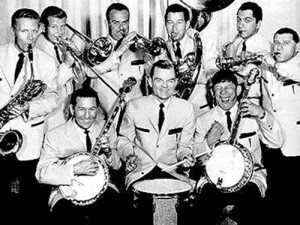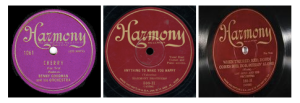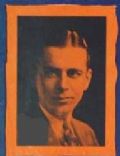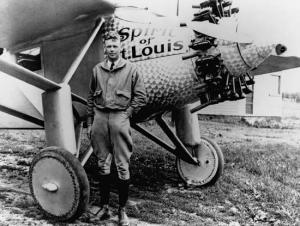This week on Zayde’s Turntable we find a somewhat untraditional type of record. While the song and the performer are not that remarkable I was looking forward to posting about one of the several albums in my collection from the intriguing “Hit of the Week” label.

Examples of “Hit of the Week” label, with the monochrome illustrations on the back of some of the records depicted on the right.
“Hit of the Week” (HOTW) were a very unique series of albums issued in the 1930s, at the height of the Great Depression, which were made – not of the standard shellac – but instead of a patented paper/resin product called Durium. Simply put, HOTW records, first issued in February 1930, were an ultra-cheap record for the impoverished nation. Each week the newest HOTW record appeared in flimsy rice-paper sleeves on newsstands (not, as with other records, at record stores) for just 15 cents – the cheapest record available at the time. Despite the fact that they were printed on paper stock and not vinyl, HOTW records had remarkably good audio quality, often matching or exceeding the quality of shellac records of the same period. The single-sided records were sometimes issued with liner notes or the featured artist’s picture illustrated on the back (a feature missing from this particular album, however). By the summer of 1930, at its peak, HOTW were selling nearly 500,000 records each week (at 15 cents per record, that makes a weekly gross of $75,000 – or about $970,000 in today’s dollars); however, the continually worsening economy quickly claimed even the super cheap HOTW record company. Sales crashed and in March 1931 the company went into receivership. Two months later they were purchased by an advertising agency that attempted to revive the label, expanding the discs to five minutes in length, with two songs per record – still only on one side, and raising the price to 20 cents. The changes did not work and the final HOTW was produced in June 1932. The advertising industry continued to utilize Durium printed records throughout the decade, primarily as 5” and 3” promotional records. The agencies would even print the mailing address and affix postage directly onto the reverse of the miniature paper records. HOTW records are today relatively popular with collectors – even those with less remarkable songs or singers – largely due to the medium upon which they are pressed. HOTW did publish a number of A-list musicians’ works, however, including Duke Ellington (who appeared on the label as part of the group the “Harlem Hot Chocolates”), Eddie Cantor, Rudy Vallee, and Gene Austin.
This album is in Very Good condition. It has a small chip at the edge, but it does not intrude on the grooves at all and has no effect on the recorded audio. It is an acoustically recorded 10-inch diameter 78-RPM brownish red Durium paper/resin disc with lateral grooves and a ¼” spindle hole. The record catalog number is Hit of the Week 1088. The A-side recording features the Vincent Lopez (1895-1975) Orchestra directed by Hymie Wolfson playing the foxtrot “Little White Lies” by Walter Donaldson (1893-1947). The vocalist is Lew Conrad and it runs 2 minutes and 38 seconds. The album was recorded in July 1930 and released by HOTW on September 11, 1930. Les Docks sets the value at $3-$6 and there is one dealer selling it on EBay for $4.
Donaldson originally wrote the 1930 foxtrot “Little White Lies” for Fred Waring’s Pennsylvanians, who recorded it on July 25, 1930 for Victor, with Clare Hanlon providing the vocals. As this HOTW version attests, several artists ended up recording the popular tune in 1930, including – besides Lopez on HOTW – Ted Wallace on Columbia, Earl Burtnett on Brunswick, Johnny Marvin on Victor, Marion Harris on Brunswick, Lee Morse on Columbia, and Harry Reser and Annette Hanshaw on budget labels like HOTW. Jesse Crawford recorded an instrumental organ cover for Victor in 1930, as well. Ella Fitzgerald recorded a version of it for Decca in 1939 with Chick Webb’s orchestra. The greatest heights that the song achieved on the US charts was when a 1947 recording of the tune by Dick Haymes for Decca lasted 23 weeks on the Billboard charts, peaking at #3 in 1948. Dinah Shore’s 1947 cover of it for Columbia records lasted one week on the charts at #28 and a 1957 version on Bally Records by Betty Johnson lasted one week at #25 in that year. The song was a hit overseas, too, with Ruby Murray recording it for UK Columbia in 1957 and Eartha Kitt doing likewise in 1963 for the same label. According to Paul McCartney the song was a favorite of both him and John Lennon when they were growing up in Liverpool, and likely had some influence on their later output.

This 1930 edition of the sheet music for “Little White Lies” features a photograph of Vincent Lopez. Donaldson’s publishing company simultaneously released versions of the same music with the photographs of a number of other performers who released recordings of the tune, including Ethel Merman, Rudy Vallee, Kate Smith, and Jesse Crawford.
Donaldson, the son of a piano teacher, began writing original music for school productions as a young boy, demonstrated sheet music for customers in five-and-dime stores, and accompanied nickelodeon films in his neighborhood in Brooklyn. He saw his first published work when he was 22 and continued to perform, even after his enlistment in the Army, when he would entertain troops and play the piano at War Bond rallies. After his service in the Army during World War I Donaldson was picked up by the Irving Berlin Music Company to be one of their stable of in-house songwriters, a gig he kept until 1928 when he set up his own music publishing company. Around the same time he moved from New York to Hollywood, to join many of his fellow Tin Pan Alley songwriters in composing music for the burgeoning film industry; his film music credits include Glorifying the American Girl, Suzi, The Great Ziegfeld, Panama Hattie, Follow the Boys, and Nevada. By the time of his death in 1947 the tremendously prolific Donaldson had penned around 600 original songs, including some major smash hits that are synonymous with Tin Pan Alley and the music of the 1930s to this very day: “My Blue Heaven,” “Yes Sir, That’s My Baby” recorded by John Pizzarelli, “My Baby Just Cares for Me,” “I’ve Had My Moments” made famous by Frank Sinatra, “You’re Driving Me Crazy” rendered by Mel Torme, “Makin’ Whoopee,” and “Love Me or Leave Me” sung by Lena Horne. Remarkably, Donaldson’s publishing company is still in existence to this day and maintains a terrific website with the composer’s complete biography, his catalog with representative recordings (including a 1995 recording of Julie London singing “Little White Lies” for Liberty records), and information about licensing any of the composter’s 600 odd songs.
Lopez, like Donaldson, was a Brooklyn kid. The song of Portuguese immigrants, Lopez was on track to become a priest before he found a new calling in music and formed his own dance orchestra in 1917. With Lopez at the piano, the band played numerous hotel and dance gigs throughout New York City. Lopez’s piano technique has been called “flamboyant and florid” and was a direct influence on later performers on the instrument, including Liberace. Numerous musicians who would later go on to fame in their own right spent some time in Lopez’s band, including Artie Shaw, Xavier Cugat, Jimmy and Tommy Dorsey, Rudy Vallee, and Glenn Miller. In November 1921 the Lopez orchestra became one of the first to broadcast a regular radio program – a 90-minute weekly show on WJZ out of Newark. The notoriety from the show propelled Lopez to the front line of famous bandleaders of the 1940s and secured both his band and himself roles in a number of the hottest musical movies of the 1940s.
In 1941 Lopez and his band began a long-term residency as the house band of the Hotel Taft in New York City, delighting audiences into the late 1950s with swing, dance tunes, Dixieland jazz, country-western, and even, in the 1950s, with rock and roll songs. The liner notes to a “Best of the Big Bands” CD compilation from the 1990s offers this description of the show at the Taft:
The Lopez band practically defined the style of popular hotel orchestras of the time…Lopez was also an innovator when it came to the audience participation stunts that generated publicity. Wednesdays through Fridays, for instance, Lopez would have everybody in stitches at the Grill Room with his “Shake the Maracas” show, in which people came great distances to demonstrate their personal skill with the maracas and compete for such prizes as miniature piano cigarette lighters and autographed photos of the bandleader. On many an afternoon, tourists (and hooky-playing office workers) would head off to the Taft for an hour-long 1:00 PM dance session, often broadcast as “Luncheon With Lopez” over the Mutual Radio Network. He even sponsored “Fashions in Music,” a weekly afternoon fashion show in which models would display the latest in day and evening wear to the instrumental melodies of the band. Such novelties may have diminished the impact of his music, but it never affected his pocketbook – or his ability to hire the best musicians in town. For many years, a spot in the Lopez band was a real plum for a musician who also desired a stable family life; the show at the Taft always ended at 9:00 PM sharp, giving a sideman ample time to change into street clothes and be home in time to kiss the kids goodnight and watch the eleven o’clock news.
Lew Conrad was, like Donaldson, the son of a musical family, with both parents sharing a background as vocalists. They decided they did not want their son to be a – gasp – singer, so they had him take up the violin instead. Conrad was promoted by his parents as a violin prodigy for the vaudeville circuit, but he really did not enjoy that realm of the entertainment world. After graduating from Tufts Conrad took his violin to the Cleveland Symphony for a year, before landing a singing and violin gig with the Leo Reisman Band. Conrad also did recording sessions with the studio orchestras of Nat Shilkret and Ben Selvin, until, in 1929, he landed an audition for NBC, who offered him a contract. Conrad’s fame peaked between 1931 and 1933, shortly after he recorded this record for HOTW. His musical performances were being heard nationwide nine times a week on NBC network radio and in 1933 his band was featured in an installment of a series of musical film shorts. His fame seemed to have tapered off, for unknown reasons, into the late 1930s, with the last news account of the band performing coming in 1941.
During times of severe economic hardship the American people have gone with less or gone without, but our innate appetite for entertainment seems to persist, albeit in a diminished form. Consider the last twelve years of movie attendance: during the recession in 2008 1.37 billion tickets were sold at cinemas, just about the same as the number sold in 2000, before the recession after 9/11/2001. At the same time, the dollar amount spent on tickets when considering those two years increased by $2.37 billion – or 32%. This means that despite a tremendous jump in ticket prices and the hit to the economy, people were still willing to shell out for a movie ticket. The HOTW story, as a label, illustrates is just how truly awful the Great Depression was for the average American family. Despite our national natural thirst for escapism entertainment even the cheapest record label of the period felt the sting of the economic collapse. And while Americans were turning to new forms of entertainment around the same time – “talkie” film features, for example – the notion that the industry that was then, and is still today, our leading entertainment industry couldn’t cope is a telling piece of evidence of the disruption of the Depression. On a lighter note, I think any record collector with a stack of HOTW albums in their collection would tell you that the audio quality is generally just as good as their vinyl discs. And they’re a hell of a lot easier to move – and less likely to shatter when you drop one by mistake, as you will inevitably do. Perhaps if the Depression had not been as bad as it was Durium records would have replaced shellac more broadly as the preferred material for record albums. Considering the trajectory of recorded music, from 78-RPM to LP to tapes and CDs, it is interesting to imagine what innovations would have happened, not happened, or happened differently, if the principle medium of recording was so changed.

































































